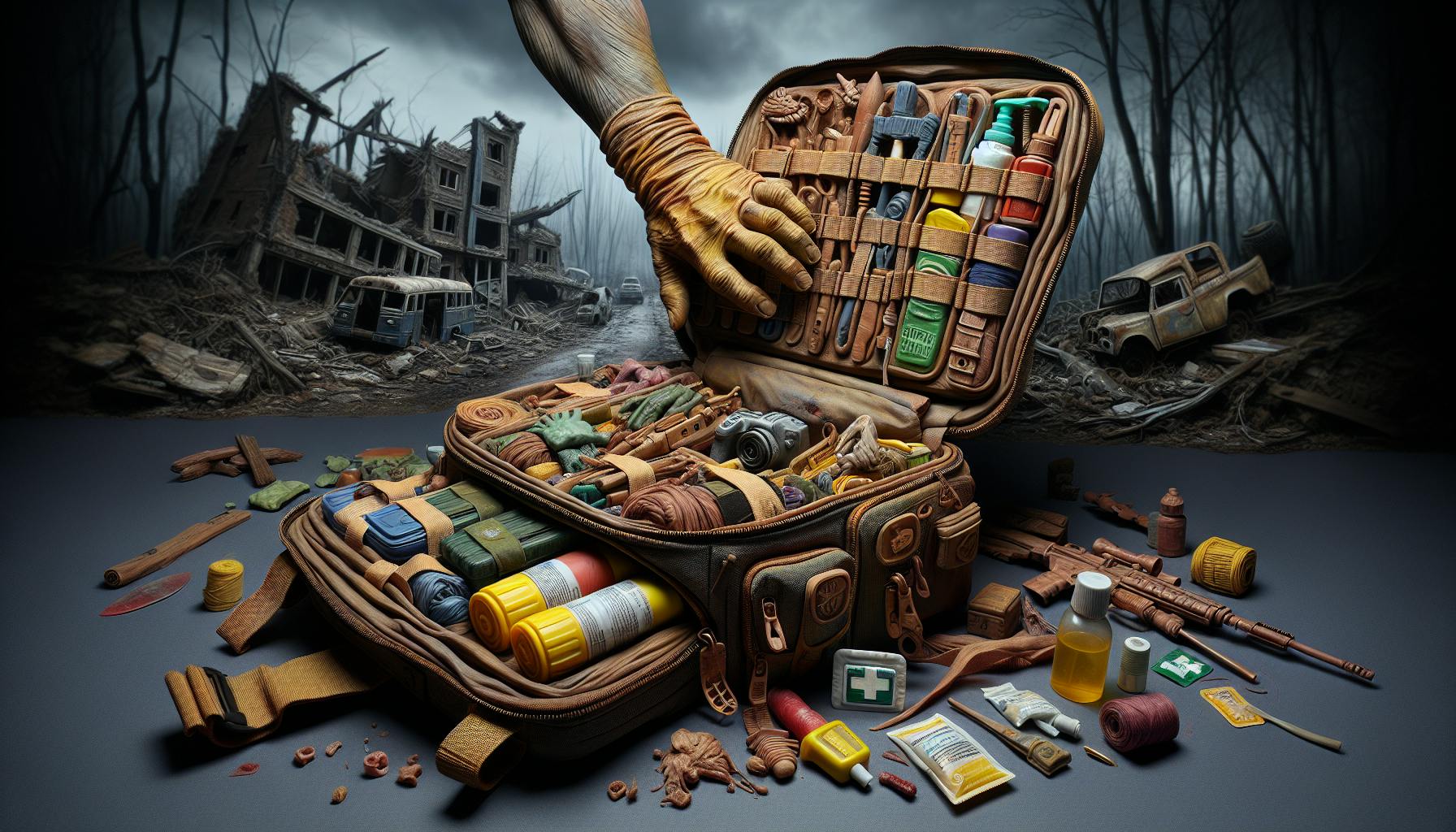When facing an emergency, most people would agree that having versatile, multi-purpose tools can make a critical difference.
It turns out one of the most versatile items you can have is simple duct tape. With some creativity, duct tape can assist in over 100 survival uses from medical care to shelter improvements.
In this article, you'll discover a series of ingenious duct tape survival hacks that can get you out of a bind in an emergency. From splinting injuries and preventing blisters to repairing gear and weatherproofing shelters, duct tape deserves a spot in every survival kit.
Introduction to Duct Tape Survival Uses
Duct tape has long been a versatile tool for repairs and projects around the home. But few realize just how useful duct tape can be when it comes to survival situations. Its durability, adhesion, and water resistance make duct tape a perfect addition to any emergency preparedness kit.
This article will explore creative ways duct tape can assist with first aid, gear repairs, leak prevention, and more when you find yourself facing uncertain conditions outdoors or during a disaster scenario. Read on to uncover duct tape techniques that just might save the day.
The Versatility of Duct Tape in Survival Scenarios
Duct tape is often called "the handyman's secret weapon" due to its incredible versatility. This versatility also makes it invaluable for outdoor survival purposes. Duct tape is durable enough to withstand the elements, yet still pliable enough to wrap around uneven surfaces. Its extra-strong adhesive bonds to nearly any material from wood and metal to fabric and plastic. It also has a waterproof backing, making it useful for preventing leaks.
With a good quality duct tape, you can patch holes, bind items together, create shelters, repair gear like backpacks and boots, prevent blistering, capture small game, and more. Duct tape requires no power tools or special skills to use. Just tear off a piece and press it firmly into place. Carrying a mini roll in survival kits provides peace of mind without much added weight or bulk.
Essentials for Your Duct Tape Survival Kit
To maximize the usefulness of duct tape for emergencies, be sure to pack the following additional items:
- Multi-tool - for cutting duct tape and materials to size
- Scissors - alternate cutting tool if no multi-tool available
- Safety pins - secures cut duct tape pieces temporarily
- Markers - labeling duct tape uses
- Gloves - protects hands when applying duct tape
Is duct tape good for survival?
Duct tape can be an extremely useful tool for survival situations. Here are some key reasons why duct tape is good to have on hand:
Strength and Durability
-
Duct tape is very strong and durable. By twisting or braiding duct tape, you can create even stronger ropes and cords to use for securing gear, setting up shelters, and more.
-
Even inexpensive duct tape has a surprising amount of strength when twisted or layered. Creating duct tape cords and ropes allows you to build necessary structures and secure items.
Multiple Survival Uses
-
Duct tape has a wide variety of potential uses in emergency and survival contexts:
-
Create emergency bandages and first aid tape
-
Patch holes and repair damaged gear
-
Prevent insect bites by wrapping duct tape around arms/legs
-
Waterproof containers and packages
-
Create cordage for securing items
-
-
With some creativity, duct tape can assist with nearly any survival need, from medical to food gathering. Its versatility makes it a lightweight must-have for any emergency kit.
Convenience
-
Duct tape takes up very little space but provides many critical functions. It's an ideal item to include in any survival or emergency preparedness kit.
-
Having a duct tape roll on hand saves you from needing multiple types of rope, bandages, tape, etc. It's an all-in-one tool for solving many issues during disasters or outdoor excursions.
In summary, duct tape can make a superb addition to any survival or emergency kit due to its incredible strength, versatility, and space-saving convenience. With some clever problem-solving, duct tape may just save your life one day. Having duct tape readily available is wise for all preppers and survivalists.
What is the use of duct tape in emergency kit?
Duct tape can serve many critical purposes in an emergency preparedness kit. Here are some of the top uses:
First Aid
- Temporary bandages or sutures
- Closing sucking chest wounds from gunshots
- Securing splints
Duct tape makes an excellent temporary solution for wounds, breaks, and leaks until proper medical treatment can be received. The adhesive is strong enough to hold cuts closed, affix bandages, or stabilize injured limbs when wrapped.
Preventing Damage
- Wrapping and securing broken windows
- Insulating exposed pipes from freezing
Duct tape can patch holes, prevent shattering, insulate pipes, and reduce further damage in a crisis scenario like a natural disaster or accident. It's useful for quick fixes until permanent repairs can be made.
Gear Repairs
- Fixing broken backpack straps
- Re-securing tent poles
- Temporarily patching clothing or shoes
Duct tape can make on-the-go repairs for all types of survival gear, keeping essentials functioning during an emergency situation. It can temporarily fix most material failures.
With its versatility, duct tape is a perfect addition to any emergency go-bag. It can solve a wide range of problems in a pinch, making it an indispensable tool for preppers.
Can you cover a wound with duct tape?
Yes, you can cover a wound with duct tape in an emergency situation. However, be aware that duct tape is much stickier than regular medical tape.
When it comes time to remove the duct tape, it will likely reopen the wound as it pulls at the sensitive skin and newly formed scab. For this reason, duct tape bandages should only be used as a last resort for wound care.
Here are some tips on using duct tape for first aid:
-
Thoroughly clean the wound first to prevent infection. Apply antibiotic ointment if available.
-
Make sure the skin around the wound is dry before applying duct tape.
-
Apply gauze pads or a non-stick bandage over the wound before layering duct tape on top. This protects the wound and makes duct tape removal easier.
-
Wrap duct tape completely around the injured area to keep the bandage secure, but avoid wrapping too tightly.
-
Check the duct tape bandage frequently to watch for signs of irritation or infection.
-
Replace the duct tape bandage every 48 hours if possible.
-
Remove duct tape slowly and carefully parallel to the skin's surface to minimize reopening the wound.
While duct tape bandages can work in a pinch, they should be switched out for proper medical treatment as soon as possible. Only use duct tape on wounds if you have no other choice.
Duct Tape Uses in Medical Emergencies
Duct tape can serve crucial first aid purposes when professional medical care is not available. Its versatility allows for improvising solutions to treat injuries and provide care until proper treatment can be accessed.
Creating Duct Tape Bandages and Gauze
- Clean wounds thoroughly before bandaging. Use filtered or boiled water if clean water is limited.
- Layer 2-3 strips of duct tape, sticky side facing outwards, to create a sterile bandage surface.
- Fold or cut sterile gauze pads to size and apply to wounds before bandaging with the duct tape.
- Wrap duct tape bandages around injuries, being careful not to restrict circulation.
- Change dressings daily, reapplying duct tape bandages over clean gauze.
Stabilizing Injuries with Improvised Splints
Duct tape applied to rigid objects like branches or magazines can create emergency splints to immobilize fractures until medical care is available.
- Find a rigid item like a branch, magazine, or piece of wood to use as a splint structure.
- Apply several layers of duct tape sticky-side out over the rigid item, leaving a non-sticky side facing the injury.
- Carefully place the splinted item next to the broken bone without causing further injury.
- Use duct tape to securely fasten the splint above and below the fracture site. Check for circulation issues.
- Monitor for increased swelling and loosen splint if circulation is compromised.
Duct Tape for Blister Prevention and Care
Duct tape can help prevent and treat blisters when trekking long distances by reducing friction on the skin.
- Apply strips of duct tape over blister-prone areas like heels and toes before setting out to create friction barriers.
- Check feet regularly for hot spots and reapply tape as needed to prevent blister formation.
- Cover existing blisters with small pieces of duct tape to protect broken skin from further irritation as you continue activity.
- Change duct tape dressings daily, cleaning the area thoroughly before reapplying.
sbb-itb-b932644
Duct Tape for Gear Repair and Maintenance
Duct tape can be an invaluable tool for repairing and maintaining gear while out in the wilderness. Having a roll or two in your pack allows you to creatively fix items and prolong their use when replacements may not be available.
Mending Tears and Patching Holes
If your jacket gets a rip or your tent springs a leak, don't despair! Simply place a piece of duct tape over the damaged area as a temporary patch. Make sure to thoroughly clean and dry the surface first so the tape adheres properly. You can cut or tear off duct tape strips to fit all kinds of tears and holes. This quick fix should hold until you can properly mend the item later.
Reinforcing Weak Spots on Equipment
Duct tape comes in handy for preventively strengthening vulnerable areas prone to wear and tear. For example, wrap some tape around spots on your shoe soles that tend to crack or places on pack straps that may fray from friction. The tape provides an added protective barrier against normal use and seasonal elements. Periodically check reinforced spots to replace worn tape.
Sealing Leaks with Duct Tape
Should your water bottle, hydration pack, or food containers spring a leak, don't lose precious provisions! Simply dry the equipment fully and firmly apply a piece of duct tape over the problem area to seal small holes or cracks. You can use extra tape to fully encase leaky areas if needed. This should stop almost any leak temporarily until you can properly replace the item. Just be sure to check the tape adhesion frequently.
Enhancing Shelter and Comfort with Duct Tape
Duct tape can be an invaluable tool for enhancing shelters and comfort when better options are unavailable. Here are some key ways duct tape can help:
Weatherproofing Shelters
- Seal small holes, gaps, and cracks around windows, doors, walls, roofs, etc. to regulate temperature and keep out drafts, moisture, pests/insects
- Tape clear plastic or tarps over broken windows and openings to shelter from wind, rain, snow
- Create waterproof duct tape seals around pipe and wire penetrations
Repairing Structural Damage
- Temporarily patch holes in tents, tarps and damage to structures by layering duct tape
- Tape punctures or rips in air mattresses, sleeping pads, and inflatable gear when replacements aren't accessible
- Bind cracked PVC, fiberglass, wood materials when new parts can't be acquired
Creating Insulation and Heat Retention
- Wrap duct tape around water bottles or containers to create improvised hot water bottles
- Tape space blankets or insulating materials to walls, ceilings to contain heat
- Fashion an insulated sleeping bag using duct tape and other available materials
With some creativity, duct tape can vastly improve shelter conditions in a pinch. It excels at sealing openings, making repairs, and improvising insulation when better options aren't available.
Crafting Essential Survival Tools with Duct Tape
Duct tape can be an invaluable tool to have on hand in emergency situations when access to commercial gear is limited. With some creativity, strips of duct tape can be fashioned into a variety of useful survival items.
Making Duct Tape Cordage for Various Uses
- Cut long strips of duct tape, about 1/2 inch wide
- Twist or braid 3-5 strips together tightly
- Creates strong, durable substitute cordage
- Use for gear repairs, securing items, creating traps
Duct tape cordage is versatile and can be used in place of rope, ties, or latches when improvising fixes or crafting survival tools from found objects. Having a reliable roll of duct tape and the knowledge to transform it into serviceable cordage is a key addition to any emergency kit.
Constructing Duct Tape Containers for Storage
- Layer strips in overlapping pattern to form bottom surface
- Build up sides with strips in circular pattern
- Fold top edge over to create rim of container
- Seal seams thoroughly with extra tape
Impromptu duct tape buckets, bowls, and other vessels can hold vital supplies like food, water, medicine when standard containers break or are unavailable. With practice, durable duct tape containers in various sizes can be produced quickly from tape alone when the situation demands it.
Fashioning Duct Tape Shoes and Clothing
- Cut tape strips to desired shoe upper shape and length
- Layer and seal strips over makeshift sole form
- Bind with additional tape strips for security
- Layer tape strips into impromptu hats, gloves for protection
Though uncomfortable for extended wear, temporary duct tape shoes, hats, and gloves can shield against the elements in a pinch. These extreme, last-resort garments should only be utilized long enough to seek more suitable gear or shelter from environmental hazards.
Additional Practical Duct Tape Survival Hacks
Duct tape can be an invaluable tool to have on hand in emergency situations. Its versatility allows it to be used in a variety of practical ways beyond basic first aid and gear repairs. Here are some additional survival applications of duct tape worth knowing.
Preventing Insect Bites and Stings
Outdoor pests like mosquitos, ticks, and bees can quickly become a nuisance or even a safety hazard in survival scenarios. To help prevent bites and stings:
- Seal any openings in clothing, shoes, or packs with duct tape to block insects from getting inside and reaching skin.
- Wrap duct tape sticky-side out around limbs to capture crawling bugs before they can bite. Check the tape frequently and replace as needed.
- Construct a basic beekeeper-style head net by stretching duct tape mesh-style over a hat. This can protect the face from winged insects.
Using Duct Tape for Signaling and Visibility
The reflective properties of some duct tape varieties can boost visibility and serve as an improvised signaling device.
- Secure strips of reflective duct tape to clothing, gear, shelter walls, trees, etc. to make yourself more visible.
- Construct a basic signal mirror by shaping foil duct tape into a curved shape. Use to reflect sunlight at aircraft or distant searchers.
Improvising Hunting and Fishing Gear
- Bind sticks and branches to create spears for hunting fish or small game.
- Use strips of duct tape to mend any tears or holes in existing nets or traps.
- Wrap stones or other improvised weights with duct tape to make shift sinkers for fishing lines.
With some creativity, duct tape allows vital hunting and fishing gear to be made or repaired using items on hand. This helps maintain crucial food procurement abilities.
Conclusion: The Indispensable Role of Duct Tape in Survival
Duct tape has proven itself to be an essential item for every survival kit. With its incredible versatility allowing it to be fashioned into gear, tools, first aid solutions, and repairs, duct tape fills a wide variety of critical needs when traditional solutions are unavailable.
Recapping the 100 Uses for Duct Tape in Survival
Duct tape's myriad emergency applications make it a prepper's best friend:
-
Fashioning Gear: Duct tape can craft containers, cordage, straps, ties, and more to equip you with necessary survival tools.
-
Creating Survival Tools: From spears to signaling devices, duct tape helps build specialized crisis equipment on the fly.
-
Administering First Aid: Duct tape bandages stop bleeding, support injuries, and close wounds when medical supplies run out.
-
Making Repairs: Patching holes, securing loose items, preventing leaks and insects - duct tape fixes problems in dire situations.
With so many uses spanning critical areas like gear, tools, medicine, and repairs, duct tape fills gaps that can be life-threatening. Its versatility and durability make duct tape a compact, affordable item that pays emergency dividends. No survival kit is complete without this indispensable tool.


